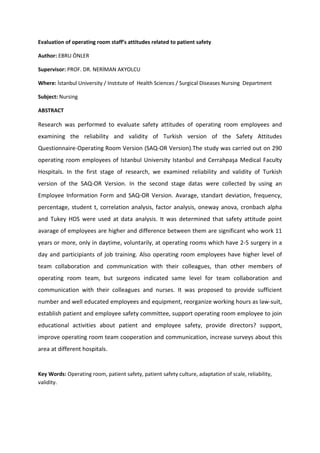PhD Thesis Abstract
- 1. Evaluation of operating room staffâs attitudes related to patient safety Author: EBRU ÃNLER Supervisor: PROF. DR. NERÄ°MAN AKYOLCU Where: Ä°stanbul University / InstÄątute of Health Sciences / Surgical Diseases Nursing Department Subject: Nursing ABSTRACT Research was performed to evaluate safety attitudes of operating room employees and examining the reliability and validity of Turkish version of the Safety Attitudes Questionnaire-Operating Room Version (SAQ-OR Version).The study was carried out on 290 operating room employees of Istanbul University Istanbul and CerrahpaÅa Medical Faculty Hospitals. In the first stage of research, we examined reliability and validity of Turkish version of the SAQ-OR Version. In the second stage datas were collected by using an Employee Information Form and SAQ-OR Version. Avarage, standart deviation, frequency, percentage, student t, correlation analysis, factor analysis, oneway anova, cronbach alpha and Tukey HDS were used at data analysis. It was determined that safety attitude point avarage of employees are higher and difference between them are significant who work 11 years or more, only in daytime, voluntarily, at operating rooms which have 2-5 surgery in a day and participiants of job training. Also operating room employees have higher level of team collaboration and communication with their colleagues, than other members of operating room team, but surgeons indicated same level for team collaboration and communication with their colleagues and nurses. It was proposed to provide sufficient number and well educated employees and equipment, reorganize working hours as law-suit, establish patient and employee safety committee, support operating room employee to join educational activities about patient and employee safety, provide directors? support, improve operating room team cooperation and communication, increase surveys about this area at different hospitals. Key Words: Operating room, patient safety, patient safety culture, adaptation of scale, reliability, validity.

